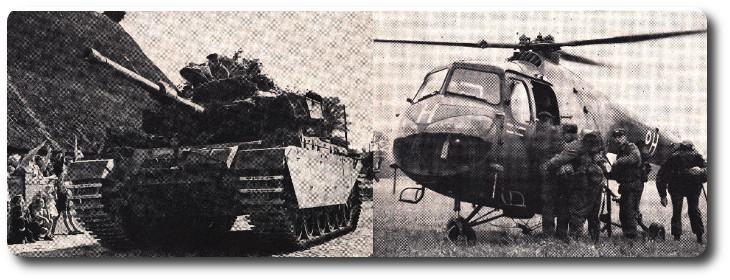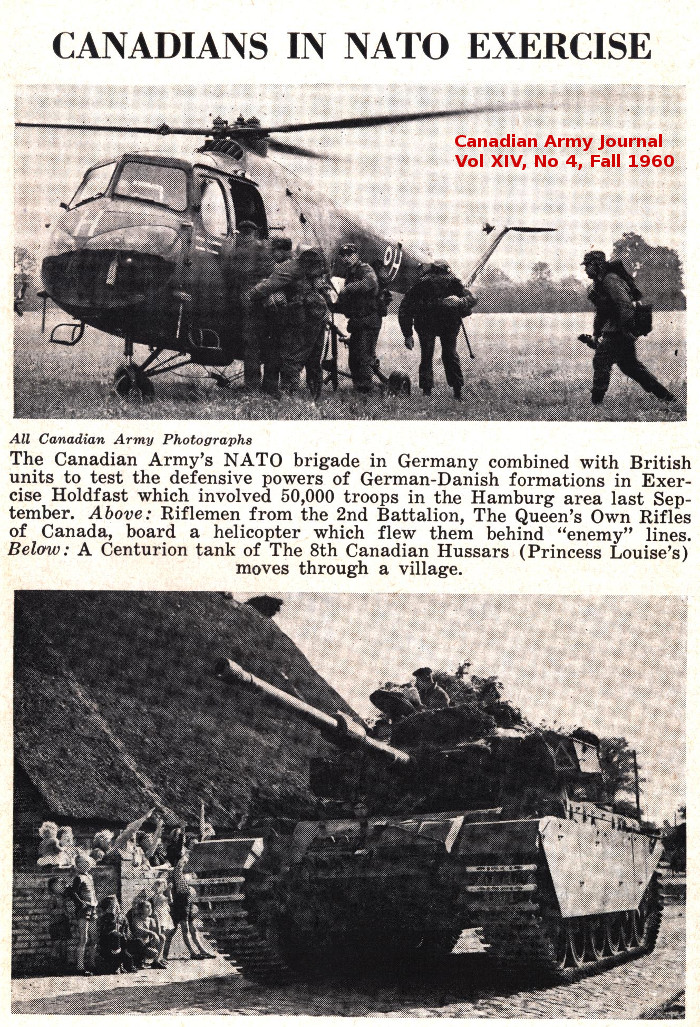Topic: Canadian Army

The Canadian Army Round-Up for 1960
The Shawinigan Standard, Shawinigan, Quebec, 21 December 1960
The year 1960 saw the Canadian Army complete a decade of the most active and extensive operations in their peacetime history in service under the United Nations, the North Atlantic Treaty organization and, at home, in the vital role of planning national survival should the holocaust of nuclear war ever become reality.
During the same year, the Army entered a new, sensitive area of the troubled world scene as part of a UN protective force to preserve peace in the month-old Congo Republic.
Canadian soldiers now serve from the Middle east to the far east, from the Arctic Circle to the Congo equatorial belt.
Since 1950, more than 67,000 troops have served abroad in fulfillment of Canada's international obligations. Nearly half of them saw service in the Korean conflict. Another 3,000 have kept Canada's 5,500-man NATO brigade group at operational strength in West Germany. Others are serving with the UN Emergency Force on the Gaza Strip and with the Truce Commission in Indochina. Canadian soldiers also serve as UN Observers in Palestine, India, Pakistan, and Korea.
Across Canada troops of both regular and militia forces have become deeply involved in a new and serious role—planning for national survival under nuclear war. Army commitments in this field include responsibility for early warning of nuclear attack to the Canadian public and re-entry operations in devastated areas.
No small part of national survival preparedness has been the intensified programme during 1960 to qualify all troops in first aid under the St. John Ambulance. Some 17,000 soldiers received their official certificates from the St. John Ambulance.
Meanwhile the regular business of the Army in training for modern warfare goes forward. Militia units rendered obsolete by changing tactics of battle have been converted or absorbed. Brigade groups of the Regular Army continue to hold large scale exercises testing new battle tactics at major camps across Canada and in Germany. Mobile column are planned for national survival duties involving both regular and militia units.
In London, Ont., the 2nd Battalion, Royal Canadian Regiment, has maintained a state of combat readiness throughout 1960 as Canada's standby force to assist the United nations if called upon.
Announcement of adoption of the 762mm Honest John rocket system was made during the past year and troops have been training on the use of the new weapon at U.S. bases. Other new weapons and equipment are undergoing field trials, notably the canadian designed troop-carrying vehicle, the bobcat.
The Army also adopted a new, NATO pattern steel helmet in 1960 and continued exhaustive trials on newly designed combat clothing and boots.
A paramount factor in adoption of any new item for the Army still evolves around possible NATO standardization.

Historical milestones of 1960 brought about the centennial year of the Queen's own Rifles of Canada, the Army's oldest infantry regiment that is but five years younger than the Canadian Army itself. One of the youngest corps—the Canadian Provost Corps—observed its 20th anniversary.
In the far reaches of the north country, a team from the Ottawa-base Army Survey Establishment covered nearly 50,000 square miles mapping little known Banks Island, northern Victoria Island and the Western Arctic Archipelago. This was done during the short summer months inside the Arctic Circle.
At the same time Canadian Army Engineers continued to maintain the vital Northwest Highway System linking Alaska over a 1,221-mile stretch of roadway. An important link in this system was restored last summer when the new peace River bridge was opened.
While the Army assumes new duties in the tropics, one of the oldest jobs in the vast Canadian north has been passed on to the Department of Transportation (DOT). Operation of the far-flung Northwest Territories and Yukon Radio System, a responsibility of the Royal Canadian Corps of Signals for 36 years, was turned over to DOT last summer.
In the realm of personal amenities, 1960 was a good year for the soldier. Troops were granted a pay increase, Maple Leaf Services (MLS), a non-profit corporation operated by and for the Army, added new shopping centres in camps Petawawa, Borden and Valcartier. MLS chalked up nearly $13 million gross in sales, by far their biggest year yet. Every penny of net profit from MLS is channeled back to the soldier in providing recreation, welfare and related services.
Although the Canadian soldier is well fed in major camps, research continues to improve his rations in the field and isolated localities. A new rapid freeze-drying method of dehydrated foodstuffs has been developed. It will provide dehydrated raw pre-cooked meats the same in taste and appearance as the original following reconstitution by cooks.
In international competition, a Canadian soldier from New Westminster, B.C., Sgt. Gunnar Westling, won the coveted Queen's prize at Bisley, England, last July. This is the Commonwealth's highest shooting award.
Early in 1960, the Canadian Army became the first in the world to complete its official history of the Second World War. The third and final volume of this history completed the official story of Canadian soldiers at way from 1939 to 1945.
Canadian troops at home and abroad are encouraged to be good citizens as well as good soldiers. In Germany and other countries they are active in community affairs and helping the under-privileged. Soldiers serve on volunteer fire departments, scouting movements and charitable organizations. They are on call in times of disaster, search and rescue and the maintenance of order. During the past year troops were on hand to fight the rampaging floods of Quebec, the forest fires of the Maritimes and to blast away with artillery guns the threatening snow avalanches in the Canadian Rockies. Working with Department of Transport last summer, Army radar groups tracked rain-making aircraft as they seeded cloud formations.
Few nations in the world with a small peacetime regular Army are today maintaining such widespread global commitments for the preservation of peace as Canada. To provide for a reasonable rotation of troops serving on the more arduous and hazardous overseas posts, many soldiers have done two of more tours abroad during the past decade.
Because few complain may be one reason why senior officials have placed Canadian Troops 'among the most adaptable and resilient in the world.'

